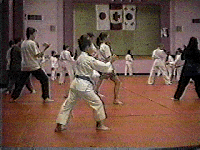
 |
Basics |
ELEMENTS OF TRAINING |
|
Part of the purpose of training is to replace inherent instinctive responses
- such as panic, covering, turning away, or clashing directly, with more
refined and effective acquired responses - such as evading, redirecting,
and dispersing a direct attack.
Seikido self defense techniques often depend upon the offenders movement, strength, weight and momentum during an attack to be effective. The particular type of attack itself contains the elements which are used to neutralize the attempted assault. Aggression can be sensed on a subliminal level before action is actually noticed. Intensive training will result in defense becoming a conditioned reflex, the body having been trained to react to a particular stimulus provided by the attack. The student must develop a proper mental condition, of concentration and direction of control. This requires a mind that is clear, flexible, and attentive. Practice will eventually lead to the fusion of mind and body, where reaction and application of proper technique becomes effortless. An assailant's body in motion is less stable than when standing in balance and therefore easier to maneuver. The faster he moves, the easier it is to use his inertia to unbalance him and disperse the attack harmlessly away. Movement and convergence with the attackers momentum is essential, strength is not. Many defensive techniques exaggerate the aggressor's movement beyond his control in an open circle projection away, or exaggerate the bend of his joints in a closed circle immobilization back into him. Movement should be with the hips around the "Hara", keeping the upper body vertical and balanced. Many movements simulate, and are based upon, sword fighting cuts, especially with a 451 inclined circle. Pain is not desirable and often not applicable, since an assailant may feel no pain during an assault. Breaking bones or joints is also not desirable, since an assailant's broken arm can not be used for leverage control. A broken neck can result in permanent disability or even death. The student must develop a state of alert awareness at all times, to be able to quickly evaluate a situation and immediately decide how to react. He must maintain a calm, dispassionate, and impartial view of events as they unfold, or even explode, around his center. The defender must never concentrate his sight upon the attacking tool, be it fist, foot, or weapon, but use peripheral vision to see all aspects of the potential attack. NOTE: Seikido self defense techniques are designed to be the most scientifically advanced and sophisticated available. If better techniques are discovered and proven to be effective, the curriculum should be changed to incorporate them. This is particularly true for defenses against multiple attackers, or attackers who are armed, or are considerably larger than the defender; in which case alternative and possibly damaging counter strikes must be employed to avoid being harmed. Life threatening defense situations may have to include bone breaking kicks or stunning strikes to vulnerable target areas in order to incapacitate or even cripple the attacker. It is important to remember that fear or exertion can cause your body to make it impossible to execute subtle movements involving fine motor skills. |
THEORY OF NEUTRALIZATION |
The practical self defense techniques of the Seikido way rely mainly upon
dynamic movements which are applications of the principles of: evasion
of the initial attack, centralization of movement, extension of energy,
dispersion of energy, and nonresistance. These strategies of neutralization
are summarized as follows:
|
THEORY OF POWER |
Stances
Strikes
Kicks
Blocks
Other
|
Created by XSystyms © Copyright 1996